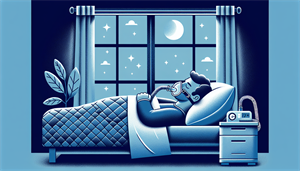Can sleep apnea cause high CO2 levels? Sleep apnea can indeed lead to elevated CO2 levels in the blood, a serious condition termed hypercapnia.
Through disrupted nighttime breathing, sleep apnea decreases the body’s ability to expel CO2, posing risks to your health.
This article explores how sleep apnea causes CO2 build-up, its potential health effects, and how to control CO2 levels effectively.
Key Takeaways
-
Sleep apnea, including both obstructive and central types, can lead to elevated CO2 levels in the blood, a condition known as hypercapnia, due to disrupted breathing and insufficient gas exchange during apneic events.
-
Diagnosing hypercapnia involves arterial blood gas analysis and other diagnostic tools such as overnight polysomnography with End-Tidal CO2 monitoring, which provide essential measurements of oxygen and CO2 levels for effective management and treatment of the condition.
-
Treatment for managing CO2 levels in sleep apnea patients consists of positive airway pressure therapies, such as CPAP and BiPAP, along with lifestyle modifications like weight loss and exercise to improve respiratory efficiency and reduce CO2 accumulation.
Exploring the Connection Between Sleep Apnea and Elevated CO2 Levels

You might wonder how exactly sleep apnea contributes to elevated CO2 levels. It’s all down to those pesky apneic events that occur during sleep. These are moments when your breathing is disrupted, usually because of a constriction in your airway. This disruption means that your body can’t regulate the levels of CO2 in your bloodstream effectively, leading to too much carbon dioxide.
Not only one type, but both obstructive and central sleep apnea have the potential to contribute to CO2 accumulation in your body. Obstructive sleep apnea is when a physical blockage prevents air from flowing in and out of your nose or mouth. On the other hand, central sleep apnea occurs when the brain fails to send proper signals to the breathing muscles. This can result in disrupted breathing during sleep. Both types can lead to severe hypercapnia if left untreated.
The Role of Apneic Events in CO2 Accumulation
Apneic events refer to brief periods when your breathing ceases. These events disrupt what’s known as gas exchange, the process that sees oxygen transferred from your lungs to your bloodstream and excess carbon dioxide moved from your blood to your lungs. If these events happen repeatedly, they can increase the resistance in your airways and lead to elevated levels of CO2, or end-tidal CO2 levels.
Furthermore, these events can result in a condition known as concomitant hypercapnia and hypoxia. This means that not only do you have too much CO2 in your bloodstream (hypercapnia), but you also have too little oxygen (hypoxia). Together, these conditions can have a range of physiological effects and should be monitored closely by a sleep medicine specialist.
Types of Sleep Apnea Contributing to CO2 Buildup
As discussed before, both obstructive and central sleep apnea, which are types of sleep disordered breathing, can lead to an increased CO2 concentration by disrupting normal breathing patterns.
Obstructive sleep apnea is the most common type and is often characterized by:
-
loud snoring
-
pauses in breathing during sleep
-
gasping or choking during sleep
-
daytime sleepiness
-
morning headaches
-
difficulty concentrating
It occurs when the muscles in your throat relax and block your airway, causing difficulty breathing and leading you to stop breathing for short periods.
On the other hand, central sleep apnea is less common and involves your brain failing to send the correct signals to your muscles that control your breathing. This means that you may stop breathing for short periods during sleep. Both types of sleep apnea can lead to the accumulation of CO2 in your body and ultimately to hypercapnia, which carries its own set of health risks.
Diagnosing Hypercapnia in Sleep Apnea Patients

Effective management and treatment of the condition relies on the identification of hypercapnia in patients with sleep apnea. The primary tool used to diagnose hypercapnia is arterial blood gas analysis. This test examines the levels of carbon dioxide and oxygen in the blood, as well as the blood’s pH level.
However, arterial blood gas analysis isn’t the only diagnostic method used. There are other tools that can be used in conjunction with this test to diagnose hypercapnia. These can include comprehensive medical histories, physical examinations, and additional diagnostic tests. All these tools together can help healthcare professionals pinpoint the cause of hypercapnia.
Understanding Arterial Blood Gas Analysis
Diagnosing hypercapnia greatly depends on arterial blood gas analysis. It works by assessing the levels of oxygen, carbon dioxide, and the acidity (pH) in your bloodstream. By doing this, it can provide accurate measurements of oxygen and CO2 levels, which are essential for detecting abnormal CO2 accumulation.
In addition to measuring oxygen and carbon dioxide levels, arterial blood gas analysis also evaluates the blood’s pH balance using a blood sample. This is done by assessing various parameters, including:
-
pH level
-
Oxygen levels (PaO2)
-
Carbon dioxide levels (PaCO2)
-
Bicarbonate levels (HCO3-)
-
Base excess or deficit
By gaining a comprehensive understanding of these factors, healthcare professionals can gain a more accurate picture of your blood gas status and diagnose hypercapnia more effectively.
Other Diagnostic Tools
Apart from arterial blood gas analysis, a variety of other diagnostic tools can be employed to identify heightened CO2 levels. These can include:
-
Specialized blood tests
-
Overnight oximetry
-
Overnight capnography
-
Blood tests for screening obesity hypoventilation syndrome.
One of these tools, polysomnography, is particularly useful in diagnosing hypercapnia. This overnight sleep test can involve End-Tidal CO2 monitoring, which measures the level of CO2 in your breath during sleep. This can aid in assessing the severity of sleep apnea and its impact on CO2 levels.
Another tool, capnography, continuously measures the concentrations of CO2 in your expired air, providing a reliable reflection of your CO2 levels and helping to diagnose and monitor sleep apnea.
Health Risks Associated with High CO2 Levels from Sleep Apnea

Various health implications can arise from high CO2 levels caused by sleep apnea. These can include:
-
Daytime hypercapnia, where you experience symptoms such as headaches, shortness of breath, and daytime tiredness.
-
Enduring consequences, such as persistent fatigue and cognitive disorientation.
-
Immediate issues such as neurological manifestations.
If left unmanaged, these health implications can have a significant impact on your overall well-being. It is important to seek treatment for sleep apnea and other sleep disorders to prevent these complications.
Thus, the problem extends beyond a disturbed night’s sleep; serious health consequences can result from elevated CO2 levels due to sleep apnea. And it’s not just your sleep that can be affected; hypercapnia can negatively impact your brain and cardiovascular systems, leading to increased acidity in body fluids, particularly the blood, and causing overall health deterioration.
The Impact of Daytime Hypercapnia
Your daily life can be significantly affected by daytime hypercapnia. It’s caused when your ventilation immediately after an apnea event is insufficient to balance the CO2 loaded during the apnea events. This results in an excessive level of carbon dioxide in your bloodstream, leading to symptoms such as:
-
headaches
-
shortness of breath
-
daytime tiredness
-
anxiety
-
excessive daytime sleepiness
However, the effects of daytime hypercapnia extend beyond this. It can also result in a range of health issues, including:
-
Confusion
-
Seizures
-
Impaired ventilatory response during sleep
-
Working memory impairment
-
Adverse effects on individuals with chronic obstructive pulmonary disease (COPD) and sleep apnea.
Long-term Consequences of Unmanaged Hypercapnia
Serious long-term health problems can develop if hypercapnia is left untreated. These can include:
-
Severe respiratory failure, potentially causing respiratory arrest
-
Seizures
-
Coma
-
Ultimately, death
Management of respiratory failure may require supportive care with mechanical ventilation.
In addition to respiratory issues, chronic hypercapnia can contribute to:
-
Cardiovascular diseases, as it is associated with an increased prevalence of cardiovascular events
-
Symptoms such as dyspnea, fatigue, confusion, and somnolence in the nervous system
-
Impact on renal blood flow and contribute to the onset or advancement of kidney dysfunction over time
Treatment Options for Managing CO2 Levels in Sleep Apnea

You might ask, how can we manage CO2 levels in patients with sleep apnea? The good news is that there are several treatment options available. One of these is positive airway pressure therapy, which includes continuous positive airway pressure (CPAP) therapy. This therapy is a widely utilized method for managing obstructive sleep apnea, where a CPAP machine is used to administer a steady stream of air pressure, maintaining open airways during sleep, decreasing the frequency of breathing interruptions, and enhancing the quality of sleep.
However, the solution isn’t confined to medical interventions. Lifestyle modifications, such as weight reduction, consistent physical activity, and abstaining from alcohol and sedatives, can also contribute to the reduction of CO2 levels in individuals with sleep apnea.
Positive Airway Pressure Therapies
Managing CO2 levels in patients with sleep apnea largely relies on positive airway pressure therapies, such as bilevel positive airway pressure. These therapies include CPAP, BiPAP, and others. A CPAP machine works by delivering humidified air through the nasal passage, generating air pressure to maintain an open airway during sleep, thus preventing breathing interruptions.
BiPAP, on the other hand, provides two pressure settings - one for inhalation and a lower level for exhalation, while CPAP provides a constant air pressure throughout. Regular use of CPAP has been shown to lower blood pressure, enhance daytime alertness, and improve overall quality of life.
Lifestyle Changes and Their Effect on CO2 Levels
Beyond medical interventions, lifestyle modifications also significantly contribute to the management of CO2 levels in patients with sleep apnea. For instance, weight loss can lead to a reduction in the diameter of the throat and pressure against the lungs, which can contribute to airway collapse during sleep. This improvement in sleep apnea can also result in a decrease in CO2 levels within the body.
Exercise can also help. Here are some exercises that can improve breathing control and reduce CO2 levels:
-
Breathing exercises that incorporate mild self-imposed hypoxic sequences
-
Exercises that increase lung capacity
-
Exercises that slow the breathing rate
-
Exercises that strengthen the diaphragm
-
Exercises that reduce coughing risk
When to Consult a Sleep Medicine Specialist

Recognizing the right time to consult a sleep medicine specialist is of utmost importance. If you suspect you have sleep apnea or if you’re experiencing symptoms of hypercapnia, such as shortness of breath and confusion, then it’s time to seek professional help.
The diagnosis and treatment of sleep apnea and hypercapnia fall under the purview of sleep medicine specialists. They assess symptoms, conduct sleep evaluations, and may administer overnight sleep tests. Treatment options may involve CPAP therapy or surgical interventions, depending on the severity of the condition and the individual circumstances of the patient.
Summary
Understanding the connection between sleep apnea and elevated CO2 levels is crucial for managing both conditions effectively. With the right diagnostic tools and treatment options, it’s possible to navigate these health challenges successfully. Remember, sleep apnea can lead to elevated CO2 levels, which can result in hypercapnia, a condition that carries its own set of health risks.
Whether it’s through positive airway pressure therapies, lifestyle changes, or a combination of both, managing CO2 levels in sleep apnea patients is achievable. However, it’s important to consult a sleep medicine specialist if you experience symptoms of hypercapnia. With their help, you can regain control of your sleep, your breathing, and your health.
Frequently Asked Questions
Does CPAP decrease CO2?
Yes, CPAP helps in decreasing CO2 levels by keeping the airway open and aiding the body in naturally removing excessive CO2.
What conditions cause high CO2 levels?
High CO2 levels can be caused by conditions such as chronic obstructive pulmonary disease (COPD), sleep apnea, lung diseases, Cushing's syndrome, kidney failure, and metabolic alkalosis. These conditions can lead to elevated carbon dioxide levels in the blood.
What happens to CO2 levels when person sleeps?
During the night, carbon dioxide levels rise when people sleep, especially with closed doors and windows, which can lead to poor air quality and hinder restful sleep and health.
Symptoms of sleep apnea?
If you're experiencing symptoms like loud snoring, gasping for air during sleep, or morning headaches, you may have sleep apnea. Seek medical attention for a proper diagnosis and treatment.
How can I tell if I have hypercapnia?
If you are experiencing tiredness, headaches, shortness of breath, and confusion, it's advisable to seek medical help as these could be symptoms of hypercapnia. Take care of your health.


